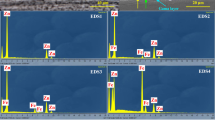Abstract
Storing and exhibiting cultural heritages are the basic social functions of museum. Since it is impossible to store or display objects without using containers, cases, or holders, the equipment quality is of great importance. Evaluating the suitability of the equipment should not only learn the mechanical behavior but also focus on the materials because some of them (such as woods) may do harm to the objects due to contaminants released. A convenient test by the deposited metal film method has been proposed previously in order to evaluate more potential museum materials in limited time. The conformance between this method and the Oddy test, the classic method for evaluating and selecting museum materials, is mainly studied in this work. The two testing systems were compared from several aspects such as sample appearance, corrosion product, surface morphology, and metallic content by naked eye and modern characterization measures like X-ray diffraction, scanning electron microscopy, and energy-dispersive spectroscopy. The corrosion mechanisms were deduced according to the corrosion products, including Cu → Cu2O → CuO and Cu → Cu2O → Cu(OH)2·H2O → Cu(HCOO)(OH). The suitability of potential materials for the conservation of metal objects was defined according to the metallic contents of coupons (calculated by atomic ratio) which were classified by the Oddy test. The critical values distinguishing permanently usable from temporarily usable are approximately determined as 70% for copper and 75% for silver, and those distinguishing temporarily usable from unusable are approximately determined as 55% for copper and 60% for silver. The corresponding metal films were classified based on the metallic content standard derived, and then typical appearances of the films assigned to different suitability levels were suggested. Special phenomena, such as the failure in detecting some corrosion products, is attributed to low yield and uneven distribution of ultrafine corrosion products on the films, the covering effect caused by other corrosion products on the copper coupons, and the weakening effect resulted from intensive metal peaks, while some unexpected corrosion conditions on the coupons and the films, are related to the characteristics of general corrosion and pitting corrosion. The results indicate the potential application of the deposited metal film method, giving an optional choice to evaluate and select museum materials with less time. The evaluation methods were preliminarily established from three aspects, such as artificial judgment, metallic content analysis, and corrosion product identification. The artificial judgment is generally applicable, and the other two are useful for verifying the result if possible. More actual cases and further calibration work are essential for further development of the deposited metal film method.

























Similar content being viewed by others
References
Bastidas JM, López-Delgado A, Cano E, Polo JL, López FA (2000) Copper corrosion mechanism in the presence of formic acid vapor for short exposure times. J Electrochem Soc 147:999–1005
Cano E, Torres CL, Bastidas JM (2001) An XPS study of copper corrosion originated by formic acid vapour at 40% and 80% relative humidity. Mater Corros 52:667–676
Chen B, Mei R, Li J, Wang J, Shi J, Yan Z, Ruan D, Lin P, Liu L, Zhang Q (1992) Inorganic chemistry. Higher Education Press, Beijing (in Chinese)
Chen H, Kong L, Chen J, Wang S, Wu L, Zhou X (2009) Metal film coupon test for evaluation and selection of materials used in museum objects. Sci Conserv Archaeol 21(S1):40–47 (in Chinese)
Echavarría A, Echeverría F, Arroyave C, Gil H (2009) Study of the copper corrosion mechanism in the presence of propionic acid vapors. J Braz Chem Soc 20:1841–1848
Fitzgerald KP, Nairn J, Atrens A (1998) The chemistry of copper patination. Corros Sci 40:2029–2050
Giorgi R, Chelazzi D, Fratini E, Langer S, Niklasson A, Rådemar M, Svensson JE, Baglioni P (2009) Nanoparticles of calcium hydroxide for wood deacidification: decreasing the emissions of organic acid vapors in church organ environments. J Cult Herit 10:206–213
Glaser JA (2017) New plastic recycling technology. Clean Techn Environ Policy 19:627–636
López-Delgado A, Cano E, Bastidas JM, López FA (2001) A comparative study on copper corrosion originated by formic and acetic acid vapours. J Mater Sci 36:5203–5211
Mori W, Kishita M, Inoue M (1980) Magnetic susceptibility and PMR spectrum of new basic copper(II) formates Cu3(HCOO)2(OH)4 and Cu(HCOO)(OH). Inorg Chim Acta 42:11–15
Oddy WA (1973) An unsuspected danger in display. Museums J 73:27–28
Platzman I, Brener R, Haick H, Tannenbaum R (2008) Oxidation of polycrystalline copper thin films at ambient conditions. J Phys Chem C 112:1101–1108
Robinet L, Thickett D (2003) A new methodology for accelerated corrosion testing. Stud Conserv 48:263–268
Scott DA (2002) Copper and bronze in art: corrosion, colorants, conservation. Getty Publications, Los Angeles
Thickett D, Lee LR (1996) Selection of materials for the storage or display of museum objects. The British Museum Press, London
Zhou X, Wu L, Song G (2009) Analysis of volatile organic acids in woods by solid phase microextraction - gas chromatography - mass spectrometry (SPME-GC/MS). Sci Conserv Archaeol 21(S1):30–32 (in Chinese)
Acknowledgements
The authors sincerely acknowledge the Research Center of Analysis and Test of East China University of Science and Technology for providing help on characterization.
Funding
This work was financially supported by Shanghai Museum Research Project.
Author information
Authors and Affiliations
Corresponding author
Ethics declarations
Conflict of interest
The authors declare that they have no conflict of interest.
Additional information
Responsible editor: Michel Sablier
Electronic supplementary material
ESM 1
(DOCX 762 kb)
Rights and permissions
About this article
Cite this article
Shen, J., Shen, Y., Xu, F. et al. Evaluating the suitability of museum storage or display materials for the conservation of metal objects: a study on the conformance between the deposited metal film method and the Oddy test. Environ Sci Pollut Res 25, 35109–35129 (2018). https://doi.org/10.1007/s11356-018-3436-6
Received:
Accepted:
Published:
Issue Date:
DOI: https://doi.org/10.1007/s11356-018-3436-6




